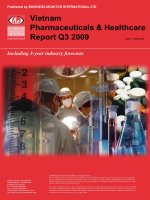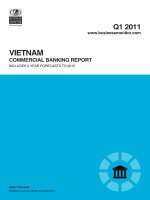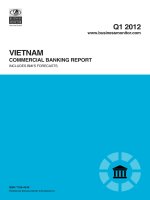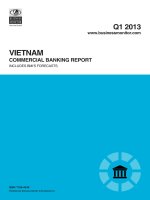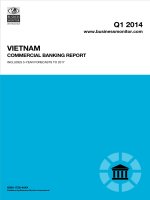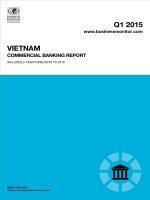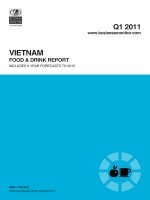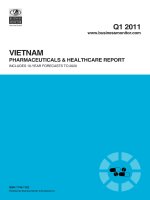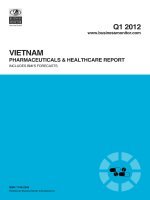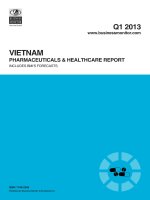Vietnam pharmaceuticals healthcare report q1 2016
Bạn đang xem bản rút gọn của tài liệu. Xem và tải ngay bản đầy đủ của tài liệu tại đây (613.2 KB, 109 trang )
Q1 2016
www.bmiresearch.com
VIETNAM
PHARMACEUTICALS & HEALTHCARE REPORT
INCLUDES 10-YEAR FORECASTS TO 2024
Published by:BMI Research
Vietnam Pharmaceuticals & Healthcare
Report Q1 2016
INCLUDES 10-YEAR FORECASTS TO 2024
Part of BMI’s Industry Report & Forecasts Series
Published by: BMI Research
Copy deadline: December 2015
ISSN: 1748-2305
BMI Research
Senator House
85 Queen Victoria Street
London
EC4V 4AB
United Kingdom
Tel: +44 (0) 20 7248 0468
Fax: +44 (0) 20 7248 0467
Email:
Web:
© 2015 Business Monitor International Ltd
All rights reserved.
All information contained in this publication is
copyrighted in the name of Business Monitor
International Ltd, and as such no part of this
publication may be reproduced, repackaged,
redistributed, resold in whole or in any part, or used
in any form or by any means graphic, electronic or
mechanical, including photocopying, recording,
taping, or by information storage or retrieval, or by
any other means, without the express written consent
of the publisher.
DISCLAIMER
All information contained in this publication has been researched and compiled from sources believed to be accurate and reliable at the time of
publishing. However, in view of the natural scope for human and/or mechanical error, either at source or during production, Business Monitor
International Ltd accepts no liability whatsoever for any loss or damage resulting from errors, inaccuracies or omissions affecting any part of the
publication. All information is provided without warranty, and Business Monitor International Ltd makes no representation of warranty of any kind
as to the accuracy or completeness of any information hereto contained.
Vietnam Pharmaceuticals & Healthcare Report Q1 2016
CONTENTS
BMI Industry View ............................................................................................................... 7
Table: Headline Pharmaceuticals & Healthcare Forecasts (Vietnam 2013-2019) . . . . . . . . . . . . . . . . . . . . . . . . . . . . . . . . . . . . . . . . . . . . . . . . . . . . . . . . . . . . . . . . . . . . . 7
SWOT .................................................................................................................................... 9
Industry Forecast .............................................................................................................. 11
Pharmaceutical Market Forecast ................................................................................................................ 11
Table: Pharmaceutical Sales, Historical Data And Forecasts (Vietnam 2011-2019) . . . . . . . . . . . . . . . . . . . . . . . . . . . . . . . . . . . . . . . . . . . . . . . . . . . . . . . . . . . . . . . . . . 14
Healthcare Market Forecast ...................................................................................................................... 15
Table: Healthcare Expenditure Trends, Historical Data And Forecasts (Vietnam 2011-2019) . . . . . . . . . . . . . . . . . . . . . . . . . . . . . . . . . . . . . . . . . . . . . . . . . . . . . . . 18
Table: Government Healthcare Expenditure Trends, Historical Data And Forecasts (Vietnam 2011-2019) . . . . . . . . . . . . . . . . . . . . . . . . . . . . . . . . . . . . . . . . . 18
Table: Private Healthcare Expenditure Trends, Historical Data And Forecasts (Vietnam 2011-2019) . . . . . . . . . . . . . . . . . . . . . . . . . . . . . . . . . . . . . . . . . . . . . . . 19
Prescription Drug Market Forecast ............................................................................................................ 20
Table: Prescription Drug Market Indicators, Historical Data And Forecasts (Vietnam 2011-2019) . . . . . . . . . . . . . . . . . . . . . . . . . . . . . . . . . . . . . . . . . . . . . . . . . 22
Patented Drug Market Forecast ................................................................................................................. 23
Table: Patented Drug Market Indicators, Historical Data And Forecasts (Vietnam 2011-2019) . . . . . . . . . . . . . . . . . . . . . . . . . . . . . . . . . . . . . . . . . . . . . . . . . . . . . 24
Generic Drug Market Forecast .................................................................................................................. 25
Table: Generic Drug Market Indicators, Historical Data And Forecasts (Vietnam 2011-2019) . . . . . . . . . . . . . . . . . . . . . . . . . . . . . . . . . . . . . . . . . . . . . . . . . . . . . . 26
OTC Medicine Forecast ............................................................................................................................ 27
Table: Over-The-Counter (OTC) Medicine Market Indicators, Historical Data And Forecasts (Vietnam 2011-2019) . . . . . . . . . . . . . . . . . . . . . . . . . . . . . . . 29
Pharmaceutical Trade Forecast ................................................................................................................. 30
Table: Pharmaceutical Trade Data And Forecasts (Vietnam 2013-2019) . . . . . . . . . . . . . . . . . . . . . . . . . . . . . . . . . . . . . . . . . . . . . . . . . . . . . . . . . . . . . . . . . . . . . . . . . . . . . 32
Table: Pharmaceutical Trade Data And Forecasts local currency (Vietnam 2013-2019) . . . . . . . . . . . . . . . . . . . . . . . . . . . . . . . . . . . . . . . . . . . . . . . . . . . . . . . . . . . . . 32
Pharmaceuticals & Healthcare Risk/Reward Index ....................................................... 33
Asia Pacific Risk/Reward Index ..................................................................................................................
Vietnam Risk/Reward Index .......................................................................................................................
Rewards ..............................................................................................................................................
Risks ..................................................................................................................................................
33
40
40
40
Regulatory Review ............................................................................................................ 42
Pharmaceutical Advertising .................................................................................................................... 43
Intellectual Property Issues .................................................................................................................... 44
Corruption .......................................................................................................................................... 47
Pricing Regime .................................................................................................................................... 48
Reimbursement Regime .......................................................................................................................... 53
Pricing And Reimbursement Developments ................................................................................................. 54
Market Overview ............................................................................................................... 56
Healthcare Sector .................................................................................................................................. 57
Hospital Sector ...................................................................................................................................... 60
Table: Healthcare Resources (Vietnam 2009-2014) . . . . . . . . . . . . . . . . . . . . . . . . . . . . . . . . . . . . . . . . . . . . . . . . . . . . . . . . . . . . . . . . . . . . . . . . . . . . . . . . . . . . . . . . . . . . . . . . . . . . 60
© Business Monitor International Ltd
Page 4
Vietnam Pharmaceuticals & Healthcare Report Q1 2016
Table: Healthcare Personnel (Vietnam 2009-2014) . . . . . . . . . . . . . . . . . . . . . . . . . . . . . . . . . . . . . . . . . . . . . . . . . . . . . . . . . . . . . . . . . . . . . . . . . . . . . . . . . . . . . . . . . . . . . . . . . . . . 60
Table: Healthcare Activity (Vietnam 2009-2014) . . . . . . . . . . . . . . . . . . . . . . . . . . . . . . . . . . . . . . . . . . . . . . . . . . . . . . . . . . . . . . . . . . . . . . . . . . . . . . . . . . . . . . . . . . . . . . . . . . . . . . 61
Private Healthcare Sector ........................................................................................................................
Healthcare Insurance ..............................................................................................................................
Healthcare And Pharmaceutical Reform .....................................................................................................
Research And Development ......................................................................................................................
Biotechnology Sector ..............................................................................................................................
Clinical Trials .......................................................................................................................................
63
64
65
66
67
70
Competitive Landscape .................................................................................................... 75
Research-Based Industry .........................................................................................................................
Domestic Industry ..................................................................................................................................
Foreign Industry ....................................................................................................................................
Traditional Medicines .............................................................................................................................
75
76
77
78
Table: Multinational Market Activity . . . . . . . . . . . . . . . . . . . . . . . . . . . . . . . . . . . . . . . . . . . . . . . . . . . . . . . . . . . . . . . . . . . . . . . . . . . . . . . . . . . . . . . . . . . . . . . . . . . . . . . . . . . . . . . . . . . 79
Pharmaceutical Distribution .................................................................................................................... 80
Pharmaceutical Retail Sector ................................................................................................................... 81
Table: Key Aspects Of Good Pharmacy Practice In Developing Countries . . . . . . . . . . . . . . . . . . . . . . . . . . . . . . . . . . . . . . . . . . . . . . . . . . . . . . . . . . . . . . . . . . . . . . . . . . . 82
Company Profile ................................................................................................................ 83
DHG Pharmaceutical ...............................................................................................................................
GlaxoSmithKline .....................................................................................................................................
Sanofi ....................................................................................................................................................
Traphaco Pharmaceutical .........................................................................................................................
Vietnam Pharmaceutical Corporation (Vinapharm) .......................................................................................
83
86
88
91
93
Demographic Forecast ..................................................................................................... 96
Table: Population Headline Indicators (Vietnam 1990-2025) . . . . . . . . . . . . . . . . . . . . . . . . . . . . . . . . . . . . . . . . . . . . . . . . . . . . . . . . . . . . . . . . . . . . . . . . . . . . . . . . . . . . . . . . . 97
Table: Key Population Ratios (Vietnam 1990-2025) . . . . . . . . . . . . . . . . . . . . . . . . . . . . . . . . . . . . . . . . . . . . . . . . . . . . . . . . . . . . . . . . . . . . . . . . . . . . . . . . . . . . . . . . . . . . . . . . . . . 97
Table: Urban/Rural Population & Life Expectancy (Vietnam 1990-2025) . . . . . . . . . . . . . . . . . . . . . . . . . . . . . . . . . . . . . . . . . . . . . . . . . . . . . . . . . . . . . . . . . . . . . . . . . . . . 98
Table: Population By Age Group (Vietnam 1990-2025) . . . . . . . . . . . . . . . . . . . . . . . . . . . . . . . . . . . . . . . . . . . . . . . . . . . . . . . . . . . . . . . . . . . . . . . . . . . . . . . . . . . . . . . . . . . . . . . 98
Table: Population By Age Group % (Vietnam 1990-2025) . . . . . . . . . . . . . . . . . . . . . . . . . . . . . . . . . . . . . . . . . . . . . . . . . . . . . . . . . . . . . . . . . . . . . . . . . . . . . . . . . . . . . . . . . . . . 99
Glossary ........................................................................................................................... 101
Methodology .................................................................................................................... 103
Pharmaceutical Expenditure Forecast Model ............................................................................................ 103
Healthcare Expenditure Forecast Model ................................................................................................... 103
Notes On Methodology .......................................................................................................................... 104
Risk/Reward Index Methodology ............................................................................................................. 105
Index Overview .................................................................................................................................... 106
Table: Pharmaceutical Risk/Reward Index Indicators . . . . . . . . . . . . . . . . . . . . . . . . . . . . . . . . . . . . . . . . . . . . . . . . . . . . . . . . . . . . . . . . . . . . . . . . . . . . . . . . . . . . . . . . . . . . . . . . 106
Indicator Weightings ............................................................................................................................ 107
© Business Monitor International Ltd
Page 5
Vietnam Pharmaceuticals & Healthcare Report Q1 2016
BMI Industry View
BMI View: Vietnam will be a highly attractive market for private healthcare providers in the region.
Beyond the expected strong increases in healthcare spending, there are also significant service gaps in the
market that will provide revenue earning opportunities to companies looking to invest in the sector. These
stem from the underdeveloped state of the public health sector characterised by overcrowded hospitals and
patients with limited access to advanced medical treatments. This will in turn affect the strategies employed
by pharmaceutical firms, as private hospitals will present an alternative sales channel for high value
medicines.
Headline Expenditure Projections
■
Pharmaceuticals: VND80.73trn (USD3.81bn) in 2014 to VND92.47trn (USD4.17bn) in 2015; +14.5%
in local currency terms and +9.4% in US dollar terms. Forecast unchanged from last quarter.
■
Healthcare: VND234.91trn (USD11.08bn) in 2014 to VND258.67bn (USD11.66bn) in 2015; +10.1% in
local currency terms and +5.2% in US dollar terms. Forecast unchanged from last quarter.
Table: Headline Pharmaceuticals & Healthcare Forecasts (Vietnam 2013-2019)
2013
2014
2015f
2016f
2017f
2018f
2019f
3.295
3.808
4.167
4.586
5.222
5.938
6.715
Pharmaceutical sales, % of GDP
1.93
2.05
2.19
2.29
2.33
2.35
2.37
Pharmaceutical sales, % of health expenditure
32.5
34.4
35.7
37.0
38.1
39.0
39.7
10.146
11.081
11.655
12.386
13.702
15.227
16.925
Pharmaceutical sales, USDbn
Health spending, USDbn
f = BMI forecast. Source: WHO, National Sources, BMI
Risk Reward Index
Vietnam's Pharmaceutical Risk Reward Index score for Q116 is 48.4 out of the maximum 100. The country
scored above average for overall market expenditure and sector value growth. Consequently, with this
moderate score, Vietnam is ranked 12th (same as in the previous quarter) out of the 19 key Asia Pacific
markets, level with Thailand and Indonesia.
© Business Monitor International Ltd
Page 7
Vietnam Pharmaceuticals & Healthcare Report Q1 2016
Key Trends And Developments
■
As announced in September, under a new circular issued by Vietnam's Ministry of Health and Ministry of
Finance, patients will be allowed to pay hospital fees through their health insurance for health
examinations and treatments on weekends and holidays as long as the correct number of medical
personnel are present and assure proper professional conditions with enough equipment; the circular is
expected to help working people who face difficulties coming to check ups and treatments on weekdays.
■
In September, Vietnam's education and training ministry has ordered the department of education and
training, universities and colleges to increase awareness on health insurance programmes amongst
students, pupils and parents in a move towards universal health coverage in the country. Based on the
country's social insurance data, social health insurance covers 85% of students and pupils at present and
the participation rate is low due to poor attention being given by some educational establishments,
ineffective communication and insufficient collaboration between the education department and the
health and social insurance sectors.
■
As announced in September, the Japanese government is promoting its healthcare and preventive
medicine industries to foreign markets and Vietnam is among the targeted countries, according to the
Japan External Trade Organization's Director Yasuzumi Hirotaka. Heart diseases, diabetes and obesity
are among the biggest risks threatening the Vietnamese and people with rising incomes prefer better,
premier healthcare services that Japanese businesses can offer.
BMI Economic View
We expect Vietnam's fiscal revenue growth to accelerate on the back of a robust economy, ongoing SOE
reforms and the positive tax reform policies that have been implemented in recent years. That said, a
continued lack of spending prudence by the government will act as a drag. As such, we forecast the
country's fiscal deficit as a share of GDP to narrow marginally to 4.9% in 2016, from an estimated 5.0% in
2015.
BMI Political View
Political and economic ties between Vietnam and Japan look set to strengthen further over the coming
years, as both countries seek to forge a strategic partnership to counterbalance China's growing
assertiveness in the region.
© Business Monitor International Ltd
Page 8
Vietnam Pharmaceuticals & Healthcare Report Q1 2016
SWOT
Pharmaceutical SWOT Analysis
Strengths
■
Significant growth potential, given a large and growing population.
■
The government's commitment to developing the health sector.
■
Sizeable local generic drugs sector, which is being encouraged by the government.
■
Strong traditional medicines segment with potential to improve the non-prescription
drugs market in the longer term, as long as sufficient investment in extraction
technologies can be found.
Weaknesses
■
One of the least developed pharmaceutical markets in Asia, with low per capita
spending on drugs.
■
Counterfeit drugs account for a significant amount of market consumption.
■
No bioequivalence requirement in place for locally made generic medicines.
■
Little distinction made between prescription and over-the-counter drugs, with most
medicines available without a prescription.
■
Complex drug pricing policy biased towards local drug producers.
■
Import-reliant market, especially in terms of high-tech products and active
pharmaceutical ingredients, which makes it vulnerable to currency movements.
■
Underdeveloped primary care services and a shortage of trained pharmacists are
continuing to hamper access to medicines and product market penetration.
■
Population concentrated in rural, rather than urban, areas, preventing access to
modern drugs and encouraging dependence upon traditional medicines.
Opportunities
■
The Association of Southeast Asian Nations harmonisation initiative, including the
adoption of Western regulatory standards such as International Conference on
Harmonisation and WHO guidelines.
© Business Monitor International Ltd
Page 9
Vietnam Pharmaceuticals & Healthcare Report Q1 2016
Pharmaceutical SWOT Analysis - Continued
■
Introduction of five-year exclusivity for clinical dossier data encouraging researchbased multinationals.
■
If investment can be found for technological improvements, then there is great
potential in the traditional Chinese medicine market, in addition to fledging
biotechnology.
■
Full WTO membership improving the trading climate and potentially, in the longer
term, redressing pharmaceutical trade issues.
■
Requirement for domestic companies to comply with international good
manufacturing practices should boost exports.
Threats
■
Government resistance to aligning patent law fully with international standards
deterring multinational sector expansion.
■
Need to resolve infrastructural and power supply issues, as well as higher education
provision, before higher levels of foreign direct investment can be expected.
■
The government is increasingly interfering in the industry, protecting indigenous firms
through the use of legal trade barriers, which will affect competitiveness.
■
Pharmaceutical price inflation threatens to put medicines out of reach of the poor and
therefore limit market volume growth.
■
Legalisation of parallel imports negatively impacting performance of patented drugs.
© Business Monitor International Ltd
Page 10
Vietnam Pharmaceuticals & Healthcare Report Q1 2016
Industry Forecast
Pharmaceutical Market Forecast
BMI View: Inflation will be a major factor in these high nominal market growth rates. However, we
highlight that there is considerable scope for increased pharmaceutical consumption in a country where per
capita drug expenditure is just USD41.20. This, combined with an expanding population, higher levels of
health awareness and increased access to pharmaceuticals, creates a strong base for market growth
assuming the required resources are put into healthcare sector development.
Latest Updates
■
The prices of vaccines in Vietnam have risen by around 5% to 10% lately due to shortages and changes in
pricing policies by foreign manufacturers, according to director of Hanoi Preventive Medicine Center,
Nguyen Nhat Cam. Several factors have contributed including changes in exchange rates and the supply
and demand law coupled with the mandatory vaccination programme for all children.
■
The Drug Administration of Vietnam, part of the Health ministry, has launched an online public service
facilitating drugmakers to register drug prices. Companies will be able to submit documents, pay fees and
check the progress of documents being processed through the online platform from the beginning of
2016.
© Business Monitor International Ltd
Page 11
Vietnam Pharmaceuticals & Healthcare Report Q1 2016
Pharmaceutical Market Forecast
2010-2024 (2010-2024)
2024f
2023f
2022f
2021f
2020f
2019f
2018f
2017f
0
2016f
0
2015f
1
2014
5
2013
2
2012
10
2011
3
2010
15
Pharmaceutical sales constant exchange rate, USDbn (LHS)
Pharmaceutical sales, USDbn (LHS)
Pharmaceutical sales, % of GDP (RHS)
f = BMI forecast. Source: National Sources/BMI
Structural Trends
Vietnam's pharmaceutical market was valued at VND80.73trn (USD3.81bn) in 2014, a 16.5% year-on-year
(y-o-y) increase in local currency terms. Over the forecast period to 2019, BMI expects pharmaceutical
consumption to reach VND151.09trn (USD6.72bn) equating to a compound annual growth rate (CAGR) of
13.4% in local currency and 12.0% in US dollar terms. Over the extended forecast period to 2024, the
CAGR will be slightly lower, but will remain in double-digit figures.
Lack of control and corruption is widespread in Vietnam. Some have blamed unscrupulous practices by
pharmaceutical companies and prescribers for pharmaceutical expenditure being higher than necessary.
However, it is not just companies that bribe Vietnamese healthcare professionals. Patients pay doctors and
nurses to avoid waiting lists and receive above-average care. Those on low incomes that cannot afford 'gifts'
for staff members have to use overcrowded facilities and rely on relatives to complement the provision of
care.
© Business Monitor International Ltd
Page 12
Vietnam Pharmaceuticals & Healthcare Report Q1 2016
In fact, according to a survey by the Vietnam Union of Science and Technology Associations published on
the VietNamNet Bridge website in September 2009, gifts - which we interpret mostly as cash, but can also
be physical goods - accounted for 9% of the cost of a health check-up. The research was performed through
interviews with 140 people in rural and urban areas who had visited public and private hospitals over the
previous six months. Interestingly, 'medications/examinations/tests' only accounted for 53% of expenditure.
It is not clear how the remaining funds were spent.
Vietnam's regulators faced their greatest challenge with the country's entrance to the World Trade
Organization at the start of 2007. Foreign enterprises have been given the right to open branches in Vietnam
and to import medicines directly, although they will still be barred from distributing their products. As part
of its membership application, Vietnam pledged to set import duties at less than 5% for pharmaceutical
products and drug tariffs are expected to average just 2.5% within five years of accession.
The liberalised environment could cause problems for Vietnam's small drug production sector.
Nevertheless, while the government originally called on firms to adopt GMP standards by the start of 2010,
the deadline was extended to the end of 2010. However, it was revealed that companies that did not have
accreditation could come up with provisory regulations. Firms not planning to establish GMP standards
must either shift to other sectors or produce traditional medicines, the latter being an area with problems of
its own, as many traditional drugs are incorrectly labelled and dispensed by unqualified practitioners.
According to Savipharm, the country has 108 factories compliant to GMP-WHO, few plants compliant to
EU and Japanese GMP as of November 2011. Meanwhile in January 2012, United International Pharma
Company became the first company with a facility that is compliant with the Pharmaceutical Inspection
Convention and Pharmaceutical Inspection Co-operation Scheme (PIC/S) GMP standards.
© Business Monitor International Ltd
Page 13
Vietnam Pharmaceuticals & Healthcare Report Q1 2016
Table: Pharmaceutical Sales, Historical Data And Forecasts (Vietnam 2011-2019)
Pharmaceutical
sales, USDbn
Pharmaceutical
sales, USDbn, %
y-o-y
Pharmaceutical
sales, VNDbn
Pharmaceutical
sales, VNDbn, %
y-o-y
2011
2012
2013
2014
2015f
2016f
2017f
2018f
2019f
2.4
2.8
3.3
3.8
4.2
4.6
5.2
5.9
6.7
17.9
17.0
16.2
15.6
9.4
10.1
13.9
13.7
13.1
50,081.5 59,213.7 69,297.5 80,730.9 92,471.1
105,482.1
119,592.4
134,800.1
151,086.7
27.4
18.2
17.0
16.5
14.5
14.1
13.4
12.7
12.1
Pharmaceutical
sales constant
exchange rate,
USDbn
2.4
2.8
3.3
3.8
4.4
5.0
5.6
6.4
7.1
Pharmaceutical
sales, USD per
capita
27.1
31.4
36.1
41.2
44.6
48.6
54.7
61.6
69.0
Pharmaceutical
sales, % of GDP
1.8
1.8
1.9
2.1
2.2
2.3
2.3
2.4
2.4
Pharmaceutical
sales, % of
health
expenditure
29.0
30.5
32.5
34.4
35.7
37.0
38.1
39.0
39.7
f = BMI forecast. Source: National Sources, BMI
© Business Monitor International Ltd
Page 14
Vietnam Pharmaceuticals & Healthcare Report Q1 2016
Healthcare Market Forecast
BMI View: Over the long-term, Vietnam's healthcare sector is forecast to grow in accordance with its
strong economic growth. However, we highlight that rising healthcare expenditure does not necessarily
equate to quality healthcare provision.
Latest Updates
■
In September, Vietnam's Prime Minister Nguyen Tan Dung has signed an order, asking the People's
Committees of 63 cities and provinces in the country to extend health insurance coverage to 84.3% of the
population by 2020 via a variety of educational and incentivising measures, while by the end of 2015
around only 75.4% of the population is expected to be covered by health insurance.
■
In October, several hospitals in Vietnam have begun a service of doctors visiting homes of elder patients
and those with disabilities or chronic diseases.
Structural Trends
In 2014, healthcare expenditure reached VND234.91trn (USD11.08bn) which corresponded to year-on-year
(y-o-y) growth of 10.1% in local currency terms and 9.2% in US dollar terms. We now forecast that the
sector will reach a value of VND619.29trn (USD28.80bn) by 2024. Through to 2019 and 2024, the sector is
projected to grow at local compound annual growth rates of 10.1% and 10.2% respectively (8.8% and
10.0% in US dollar terms).
Despite a double-digit growth in healthcare expenditure, the country has yet to address the rising burden of
communicable diseases such as tuberculosis, AIDS and hand, foot and mouth disease. Much of this
increased expenditure will be on health infrastructure, which remains basic in many rural areas. Over the
longer term, this is likely to result in greater access to basic medicines.
The country's low per capita health and pharmaceutical expenditure highlights the population's poor access
to healthcare services and low affordability levels for medicines - particularly high-value drugs. This
represents a short-term challenge for pharmaceutical firms, but over the long term, we believe economic
development will aid growth in the pharmaceutical and healthcare sector. Our Country Risk team remains
bullish about the Vietnamese economy as it forecasts strong economic growth through to 2024.
In the meantime, the government has outlined plans for the investment of up to USD1.5bn in the
pharmaceutical manufacturing sector over the next 10 years to reduce reliance on imports. The money is to
be used for a variety of programmes, including upgrading technology to meet good manufacturing practice
standards, the development and expansion of the pharmaceutical supply network to poor and remote areas,
© Business Monitor International Ltd
Page 15
Vietnam Pharmaceuticals & Healthcare Report Q1 2016
the establishment of joint ventures with foreign players and achieving a greater percentage of domestic
pharmaceutical demand.
The government's intention to invest in the development of its biotechnology sector is likely to act as a
catalyst for wider industry reform, in particular concerning patent protection. However, local drug
production is still weak and incapable of meeting domestic demand, although local regulation reform on a
considerable scale is expected to attract foreign investment. In some sectors, such as vaccines, considerable
progress has been made to increase Vietnam's self-sufficiency, with the country now producing sufficient
measles vaccines domestically to meet national demand.
To help make further progress, the government has outlined plans to invest USD241mn in eight projects
within the local drug manufacturing industry. This will include the construction of four pharmaceutical
plants in the next four years. The authorities aim to have 80% of domestic demand met by local producers
by 2020, up from around 50% currently.
In a workshop help by Vietnam Ministry of Health in August 2013 in collaboration between Medical
Excellence Japan and Japan's Ministry of Economy, Trade and Industry, the two countries reiterated Japan's
support towards Vietnamese healthcare through investment in three hospitals including: Bach Mai Hospital,
Hue Central Hospital and Cho Ray Hospital.
In an interview with local media, Vietnam News, Pham Le Tuan, deputy minister of health, stated that
public hospital fees will increase progressively until 2018, in line with Decree 85/2012/ND-CP. In 2012, the
government increased the prices of three out of seven cost elements incurred by patients, which include the
cost of medicines, chemicals, consumable materials, electricity, water, equipment maintenance and others.
Under the plan developed by the Ministry of Health on increasing hospital fees, this will cover the
remaining four out of seven cost elements (beds, medical equipment, salaries, and other hospital operation
costs). These four elements were previously covered by the government.
Timeline Of Hospital Fee Increments
■
2014: Hospital fees charged to patients will include the bed cost for inpatient services and part of the cost
of their surgery.
■
2015: Fees will include medical equipment used for patient treatment, hospitals' management and
operating costs and 20-30% of hospital staff's basic salary at provincial hospitals in mountainous regions,
central highlands and district hospitals in Ha Noi and Ho Chi Minh City.
■
2016-17: Part of the hospital fee will be used to pay basic salary cost for staff at provincial hospitals,
central government hospitals and district hospitals in two major cities of Ha Noi and Ho Chi Minh City.
© Business Monitor International Ltd
Page 16
Vietnam Pharmaceuticals & Healthcare Report Q1 2016
■
Post-2018: full cost recovery policy for medical services will be implemented across the board.
The deputy health minister believes that with these increments in fees service quality will improve
considerably, as hospitals will be dependent on patients. He added that 'more patients mean more money for
hospitals and their staff.' We highlight that this is potentially regressive as patients will have to shoulder the
burden of healthcare costs due to low funding from the government. In addition, we see a risk of
overcharging by hospitals if the implementation of these increments is not properly regulated. Conversely,
hospitals may also not generate sufficient revenues despite the implementation of the regulation. In August
2013, Vietnam News reported that hospitals in Ha Noi ran into problems in applying new hospital fees due
to unclear regulations and staffing shortages.
Nevertheless, as a result of these progressive increments, we have upgraded Vietnam's private healthcare
expenditure forecast, as the increased costs will be borne by patients rather than the government. Through to
2019, we forecast that private health expenditure will increase at a compound annual growth rate of 10.9%
(9.6% in US dollar terms). This growth rate is higher than government health expenditure 9.0%, (7.7% in
US dollar terms). We highlight that the government may spend savings generated elsewhere to boost health
services, such as improving health infrastructure.
© Business Monitor International Ltd
Page 17
Vietnam Pharmaceuticals & Healthcare Report Q1 2016
Table: Healthcare Expenditure Trends, Historical Data And Forecasts (Vietnam 2011-2019)
Health
spending,
USDbn
Health
spending,
USDbn, % yo-y
Health
spending,
VNDbn
2011
2012
2013
2014
2015f
2016f
2017f
2018f
2019f
8.3
9.3
10.1
11.1
11.7
12.4
13.7
15.2
16.9
16.3
11.3
9.3
9.2
5.2
6.3
10.6
11.1
11.2
172,398.0 193,834.4 213,353.2 234,913.4 258,668.2 284,871.0 313,772.3 345,649.2 380,810.4
Health
spending,
VNDbn, % yo-y
25.6
12.4
10.1
10.1
10.1
10.1
10.2
10.2
10.2
Health
expenditure
constant FX
rate, USDbn
8.1
9.1
10.1
11.1
12.2
13.4
14.8
16.3
18.0
93.4
102.8
111.0
119.9
124.7
131.1
143.6
158.0
174.0
6.2
6.0
6.0
6.0
6.1
6.2
6.1
6.0
6.0
Health
spending,
USD per
capita
Health
spending, %
of GDP
f = BMI forecast. Source: World Health Organization, BMI
Table: Government Healthcare Expenditure Trends, Historical Data And Forecasts (Vietnam 2011-2019)
2011
2012
2013
2014
2015f
2016f
2017f
2018f
2019f
Govt. health
spend, USDbn
3.8
4.0
4.3
4.6
4.7
5.0
5.5
6.0
6.6
Govt. health
spend, USDbn,
% y-o-y
13.0
4.7
7.5
7.7
3.8
5.0
9.5
10.2
10.3
77,975.7 82,501.7 89,365.4 97,003.3
105,399.6
114,705.8
125,036.8
136,524.0
149,317.6
Govt. health
spend, VNDbn
Govt. health
spend, VNDbn,
% y-o-y
22.0
5.8
8.3
8.6
8.7
8.8
9.0
9.2
9.4
Govt. health
spend, % total
health spend
45.2
42.6
41.9
41.3
40.8
40.3
39.9
39.5
39.2
f = BMI forecast. Source: World Health Organization, BMI
© Business Monitor International Ltd
Page 18
Vietnam Pharmaceuticals & Healthcare Report Q1 2016
Table: Private Healthcare Expenditure Trends, Historical Data And Forecasts (Vietnam 2011-2019)
2011
2012
2013
2014
2015f
2016f
2017f
2018f
2019f
Private health
spend,
USDbn
4.6
5.3
5.9
6.5
6.9
7.4
8.2
9.2
10.3
Private health
spend,
USDbn, % yo-y
19.1
16.7
10.5
10.3
6.2
7.1
11.4
11.8
11.7
Private health
spend,
VNDbn
94,422.3 111,332.7 123,987.8 137,910.1 153,268.6 170,165.2 188,735.6 209,125.2
231,492.7
Private health
spend,
VNDbn, % yo-y
28.7
17.9
11.4
11.2
11.1
11.0
10.9
10.8
10.7
Private health
spend, %
total health
expenditure
54.8
57.4
58.1
58.7
59.3
59.7
60.2
60.5
60.8
f = BMI forecast. Source: World Health Organization, BMI
© Business Monitor International Ltd
Page 19
Vietnam Pharmaceuticals & Healthcare Report Q1 2016
Prescription Drug Market Forecast
BMI View: The market figures for the prescription and non-prescription sectors are blurred by a lack of
any proper distinction between the two. In fact, according to some drugstores, only 20-30% of patients buy
drugs with a prescription. Only medicines that cause dependency, such as benzodiazepines, are routinely
refused sale without a prescription. Antibiotics are the most popular drug sold without a prescription. This
has resulted in worrying levels of antibiotic resistance. For example, nearly 70% of bacteria carried by
people living in urban parts of Vietnam are resistant to penicillin.
Prescription Drug Market Forecast
2010-2024 (2010-2024)
10
100
7.5
75
5
50
2.5
25
0
2024f
2023f
2022f
2021f
2020f
2019f
2018f
2017f
2016f
2015f
2014
2013
2012
2011
2010
0
Prescription drug sales, USDbn (LHS)
Prescription drug sales, % of total sales (RHS)
f = BMI forecast. Source: National Sources/BMI
Structural Trends
By 2019, we forecast that prescription medicines will be worth VND113.41trn (USD5.04bn) at consumer
prices, posting a compound annual growth rate of 13.7% in local currency terms (thus somewhat above the
wider pharmaceutical market). In percentage terms, at this point, prescription drugs will account for 75% of
the total market, up from 74% in 2014, driven by expanded access to formal healthcare in rural areas.
© Business Monitor International Ltd
Page 20
Vietnam Pharmaceuticals & Healthcare Report Q1 2016
The market figures for the prescription and non-prescription sectors are blurred by a lack of any proper
distinction between the two. In fact, according to some drugstores, only 20-30% of patients buy drugs with
a prescription. Only medicines that cause dependency, such as benzodiazepines, are routinely refused sale
without a prescription. Antibiotics are the most popular drug sold without a prescription. This has resulted
in worrying levels of antibiotic resistance. For example, nearly 70% of bacteria carried by people living in
urban parts of Vietnam are resistant to penicillin.
Nevertheless, the growth of the prescription medicines market will outpace the growth of over-the-counters
mainly due to the influx of expensive patented products from abroad and increased demand for
sophisticated drugs. Additionally, tighter regulations in the pharmaceuticals sector as a whole are likely to
lead to the introduction of stricter dispensing guidelines with the good pharmacy practice recommendations
established in 2011.
Demographic and environmental trends will be some of the key drivers of the prescription market in
Vietnam. Respiratory problems are on the rise, including asthma and chronic obstructive pulmonary
disease, partly due to the high prevalence of smoking and partly due to poor air quality. Manufacturers of
drugs in the respiratory therapeutic category will, therefore, have considerable room for expansion over the
coming years. Similarly, increased incidence of cancer, diabetes and hypertension among the Vietnamese
population will provide scope for drugmakers to expand.
One therapeutic area that has strong potential is oncology. At an international scientific conference in April
2013, Mai Trong Khoa, deputy director of Hanoi-based Bach Mai Hospital, stated that Vietnam reports
about 110,000 new cases of cancer annually, with over 73% of patients dying from the disease - one of the
highest rates in the world. He added that the average death rate in developing countries is 68% while that
for developed countries is 49%. In January 2014 a representative from the Vietnam Social Insurance
Agency stated that cancer drugs account for a large percentage of insurance expenses. Moreover,
prescribing patterns seem to be influenced by economic considerations, with drug companies paying
commissions to doctors who promote certain types of product. The Ho Chi Minh City authorities conducted
an investigation into the practice, with findings revealing that a number of doctors were in receipt of more
than VND500mn (USD26,300) each month. The investigators looked into the prescribing of Merck & Co's
hepatitis drugs - namely PegIntron (interferon Alfa-2b) in 50mcg and 80mcg dosages, with commissions
reportedly being in the region of 10% to 30% of the drugs' cost. Joint monthly revenues for the two drugs
are reportedly in excess of VND6bn (USD315,000). In September 2012, Nguyen Thi Kim Tien echoed a
similar view stating that prescribers receive 'commission' from foreign pharmaceutical firms therefore many
prescriptions contain expensive medicines.
© Business Monitor International Ltd
Page 21
Vietnam Pharmaceuticals & Healthcare Report Q1 2016
Local industry representatives claim that large firms can therefore gain an upper hand as they can afford to
pay higher commissions, although doctors' relationships with companies also have a role to play in their
decisions. Moreover, despite the existence of hospital medicine councils - which are in charge of making
prescribing suggestions and supervising prescribing patterns - many doctors can still suggest different types
of medicines to their patients. Patients have also stated that commissions are widespread.
Table: Prescription Drug Market Indicators, Historical Data And Forecasts (Vietnam 2011-2019)
Prescription drug
sales, USDbn
Prescription drug
sales, USDbn, % yo-y
Prescription drug
sales, VNDbn
2011
2012
2013
2014
2015f
2016f
2017f
2018f
2019f
1.8
2.1
2.4
2.8
3.1
3.4
3.9
4.4
5.0
18.4
17.4
16.6
16.0
9.8
10.4
14.3
14.1
13.5
36,603.2 43,419.9 50,982.2 59,591.2 68,485.2 78,383.5 89,168.2
100,846.8
113,414.3
Prescription drug
sales, VNDbn, % yo-y
27.9
18.6
17.4
16.9
14.9
14.5
13.8
13.1
12.5
Prescription drug
sales, % of total
sales
73.1
73.3
73.6
73.8
74.1
74.3
74.6
74.8
75.1
f = BMI forecast. Source: National Sources, BMI
© Business Monitor International Ltd
Page 22
Vietnam Pharmaceuticals & Healthcare Report Q1 2016
Patented Drug Market Forecast
BMI View: Value development of the patented drugs segment - and consequently the overall prescription
segment - will be hampered by the government's plan to contain pharmaceutical costs through restrictions
on advertising and the request that hospitals and medical professionals give preference to domestically
produced drugs, as well as the fact that most of the insured now incur some sort of co-payment. Moreover,
a number of high-value drugs are due to come off patent in the coming years.
Patented Drug Market Forecast
2010-2024 (2010-2024)
100
3
75
2
50
1
25
2024f
2023f
2022f
2021f
2020f
2019f
2018f
2017f
2016f
2015f
2014
2013
2012
2011
0
2010
0
Patented drug sales, USDbn (LHS)
Patented drug sales, % of total sales (RHS)
f = BMI forecast. Source: National Sources/BMI
Structural Trends
By 2024, we expect the patented drug sector to reach VND43.88trn (USD2.04bn) but represent a lower
percentage of the total market (18% versus 22% in 2014). Over the 2014-2024 period, patented drugs are
expected to post a compound annual growth rate of 9.5% in local currency (9.3% in US dollar terms) below the rate of the overall market development.
© Business Monitor International Ltd
Page 23
Vietnam Pharmaceuticals & Healthcare Report Q1 2016
Counterfeit drugs will continue to have a detrimental impact on patented drug sales over the forecast period,
despite the government's efforts to the contrary. The global economic slowdown has fuelled demand for
cheaper drugs and counterfeit medicines are prospering as a result. Supported by the World Health
Organization, police, customs and regulatory officials in the country have begun to coordinate their
activities, although little can be done in terms of enforcement without greater commitment to intellectual
property rights as well as more stringent penalties for violators.
Corruption also has a role to play in drug prices, with commissions paid to pharmacists and doctors by sales
representatives and distributors to persuade them to prescribe their product to push up the retail price of
medicines. Such practices can only damage the industry as a whole, putting many patented products beyond
the budgets of the majority of the Vietnamese population.
Speciality medicines, such as central nervous system and cardiovascular drugs, are expected to be the key
growth area, while an increase in cancer, diabetes and hypertension will also generate product demand.
However, the basic nature of consumption is illustrated by the continued strong showing of antibiotics and
alimentary/metabolism products. The need to contain the HIV/AIDS epidemic and related health problems
will boost the antiretroviral sector, while the prevention of swine flu and similar diseases continues to drive
the growth of anti-flu drugs.
Table: Patented Drug Market Indicators, Historical Data And Forecasts (Vietnam 2011-2019)
2011
2012
2013
2014
2015f
2016f
2017f
2018f
2019f
Patented drug sales,
USDbn
0.6
0.6
0.7
0.8
0.9
1.0
1.1
1.2
1.3
Patented drug sales,
USDbn, % y-o-y
16.2
15.0
14.3
13.6
7.4
8.0
11.6
11.4
10.7
11,560.4 13,437.9 15,473.9 17,713.2 19,921.9 22,297.1 24,783.9 27,364.1
30,015.4
Patented drug sales,
VNDbn
Patented drug sales,
VNDbn, % y-o-y
25.5
16.2
15.2
14.5
12.5
11.9
11.2
10.4
9.7
Patented drug sales,
% of prescription sales
31.6
30.9
30.4
29.7
29.1
28.4
27.8
27.1
26.5
Patented drug sales,
% of total sales
23.1
22.7
22.3
21.9
21.5
21.1
20.7
20.3
19.9
f = BMI forecast. Source: National Sources, BMI
© Business Monitor International Ltd
Page 24
Vietnam Pharmaceuticals & Healthcare Report Q1 2016
Generic Drug Market Forecast
BMI View: Although the overall generic drug market is sizeable, standing at around VND41,878bn
(USD1.98bn) in 2014, approximately 52% of the overall market's value, most products were actually lowquality copies of unproven bioequivalence. The Ministry of Health is stepping up its efforts to address the
problem by enlisting the help of medical professionals in the country, in a bid to improve generic usage and
the utilisation of domestically made products in hospitals and clinics.
Generic Drug Market Forecast
2010-2024 (2010-2024)
7.5
100
75
5
50
2.5
25
Generic drug sales, USDbn (LHS)
2024f
2023f
2022f
2021f
2020f
2019f
2018f
2017f
2016f
2015f
2014
2013
2012
2011
0
2010
0
Generic drug sales, % of total sales (RHS)
f = BMI forecast. Source: National Sources/BMI
Structural Trends
Generic products are likely to continue dominating the market in volume terms, and we forecast the value of
the sector to reach VND146.72trn (USD6.82bn) in 2024, accounting for 59% of the total market (up from
the calculated 52% in 2014). Vietnam offers strong prospects for generic market growth due to low
consumer purchasing power. However, a number of obstacles still remain, such as a widespread belief that
© Business Monitor International Ltd
Page 25
